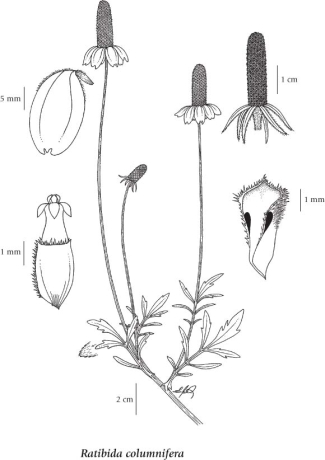Ratibida columnifera (Nutt.) Wooton & Standl.
prairie coneflower (upright prairie coneflower)
Asteraceae (Aster family)
Introduction to Vascular Plants
prairie coneflower (upright prairie coneflower)
Asteraceae (Aster family)
Introduction to Vascular Plants
Species Information
General:
Biennial or perennial herb from a taproot and short woody stem-base; stems erect, several, branched above, 0.3-1.2 m tall, stiffly coarse-hairy.
Leaves:
Basal leaves lacking; stem leaves alternate, pinnately cut, the segments linear or lanceolate and entire, coarsely short stiff-hairy, 10-20 cm long, 2-7 cm wide.
Flowers:
Heads with ray and disk flowers, few to numerous, terminal at the ends of branches; disks columnar, grey to yellow, becoming purplish-brown, mostly 1.5-4.0 cm tall, 5-20 mm wide; involucral bracts 5-10 mm long, lanceolate, reflexed when mature, hairy; ray flowers yellow or rarely purplish, 1.5-4.5 cm long, reflexed, usually 3-7; disk flowers dark, columnar.
Fruits:
Achenes flattened, fringed with small hairs and slightly winged on the inner margin and tip, grey-black, about 2 mm long; pappus an evident bristle-tooth on the inner angle of the achene, often with a shorter one on the outer angle.
Illustration

If more than one illustration is available for a species (e.g., separate illustrations were provided for two subspecies) then links to the separate images will be provided below. Note that individual subspecies or varietal illustrations are not always available.
Illustration Source: The Illustrated Flora of British Columbia
USDA Species Characteristics
Flower Colour:
Yellow
Blooming Period:
Mid Summer
Fruit/Seed characteristics:
Colour: Brown
Present from Summer to Fall
Source: The USDA
Habitat and Range
Dry grasslands and shrublands in the steppe zone; frequent locally in SE BC; E to MB and S to MN, MO, AR, TX and WA.Status Information
Synonyms
Synonyms and Alternate Names:
Lepachys columnaris (Pursh) T. & G.
Lepachys columnifera (Nutt.) J.F. Macbr.
Ratibida columnaris (Pursh) D. Don
Ratibida columnaris var. pulcherrima (DC.) D. Don
Rudbeckia columnaris Pursh, non Sims
Rudbeckia columnifera Nutt.